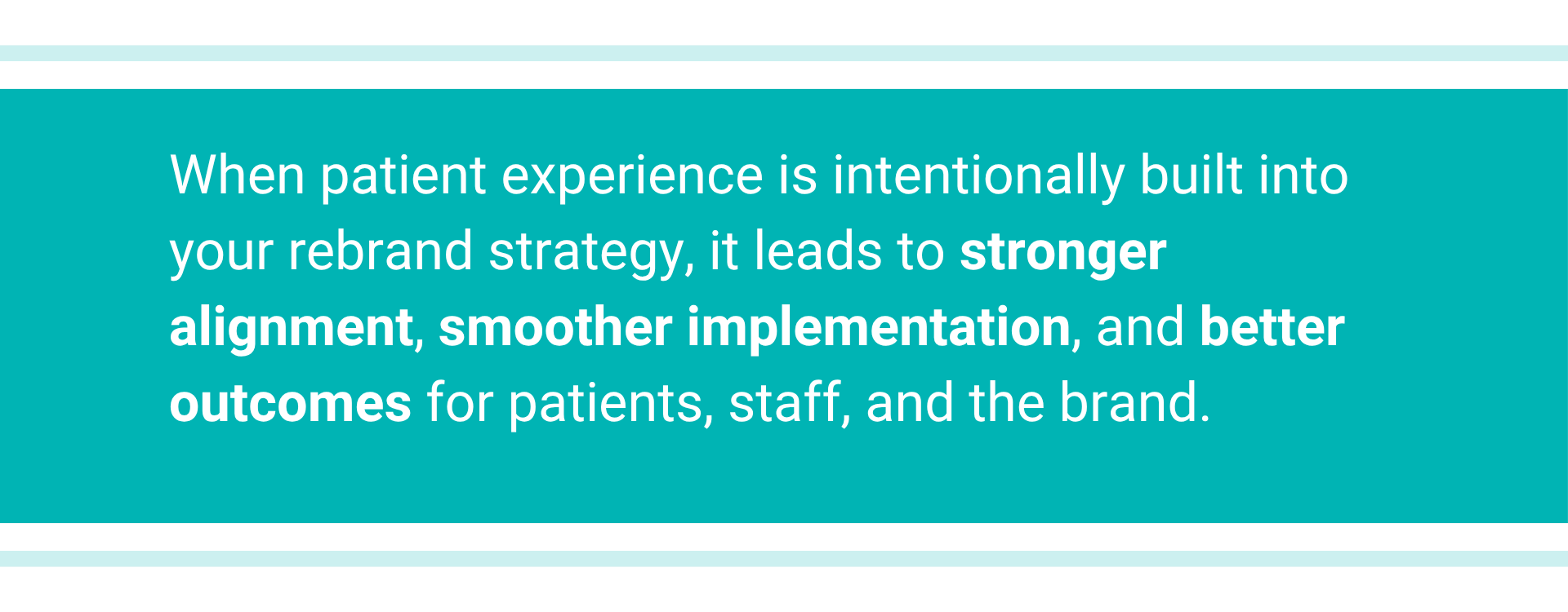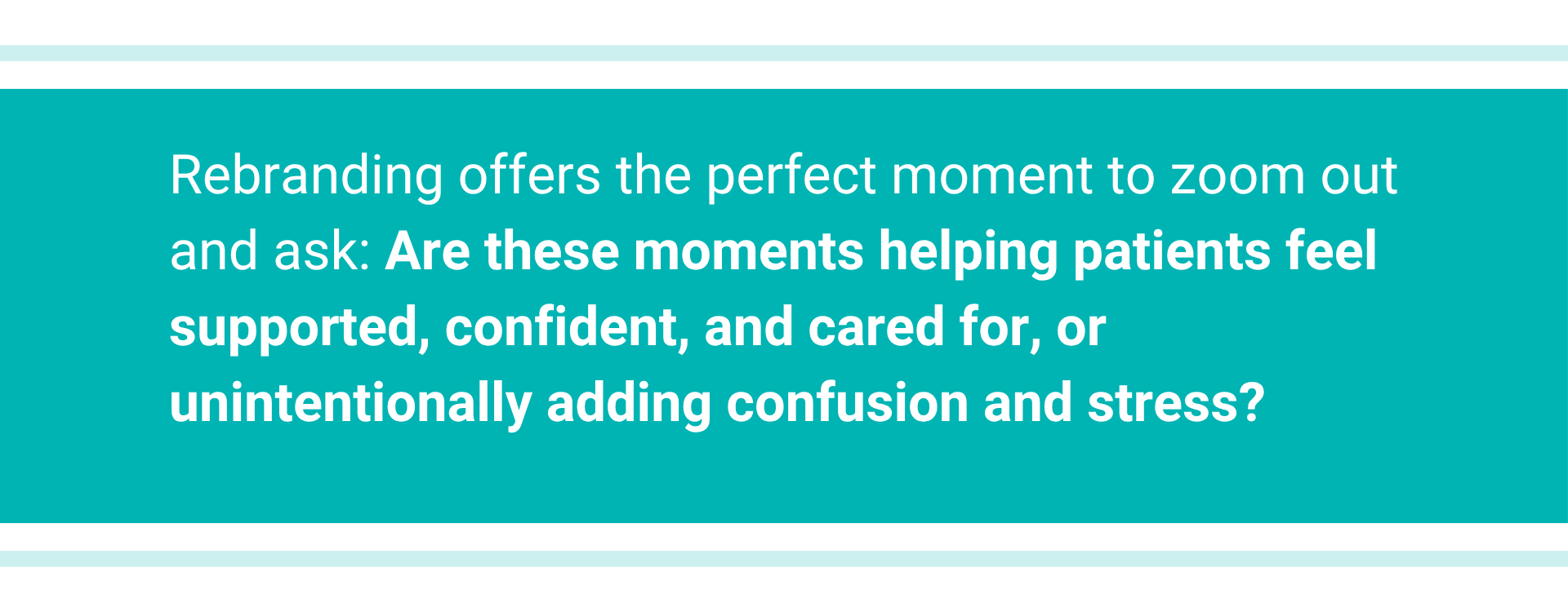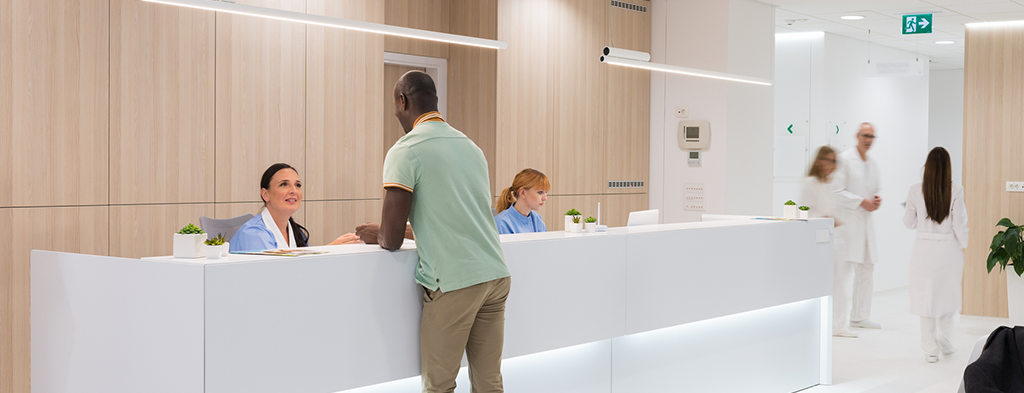A healthcare rebrand is more than a visual transformation, it’s a chance to reimagine how patients experience your brand at every touchpoint. And when patient experience is thoughtfully prioritized, every interaction becomes an opportunity to build trust, clarity, and connection.
While rebrands tend to focus on assets like signage, digital updates, and branded materials, the most impactful, enduring and profitable efforts go further — aligning brand strategy with patient experience. In this post, we explore how rebrands can serve as a catalyst for enhancing care journeys, building trust, and creating patients for life.
Why Patient Experience Deserves a Seat at the Rebrand Table
Patient experience is more than hospitality or clinical care. It’s the sum of every brand interaction across the continuum of care. That includes everything from navigating a hospital parking lot to filling out a form to interpreting signage in a high-stress moment.
Rebranding offers the perfect moment to zoom out and ask: Are these moments helping patients feel supported, confident, and cared for, or unintentionally adding confusion and stress?
The benefits of weaving patient experience into your rebrand strategy are far-reaching:
- Stronger brand trust and reputation
- Improved patient outcomes and satisfaction
- Increased staff alignment and engagement
- More efficient operations
- Reduced legal risk and complaints

What This Looks Like in Practice
Each patient journey is unique, but the brand moments within it often follow similar patterns. During a rebrand, these key touchpoints should be intentionally re-evaluated:
Digital Touchpoints
Before a patient ever steps foot in your facility, they’ve likely interacted with your website, social media, or email communications. Aligning digital brand elements with physical spaces reduces confusion and improves continuity.
Signage and Wayfinding
Clear, cohesive signage supports smoother navigation and lowers anxiety, especially in high-stakes environments like ERs or surgical centers.
Branded Environments
Everything from wall colors to uniforms can signal safety, warmth, and credibility. Even details like font legibility or consistent iconography can shape perceptions.
Staff Identification
Uniforms and ID badges aren’t just functional, they help patients quickly identify who to trust, and what roles those individuals play in their care journey.
Forms and Materials
Forms, admission kits, and printed collateral should reinforce clarity. Are they consistent in tone, design, and structure? Do they help patients feel informed and prepared?
What Gets in the Way?
Despite best intentions, rebrand execution often happens in silos, by department, by location, or by asset type. This can result in:
- Inconsistencies across digital and physical experiences
- Wayfinding that creates more confusion than clarity
- Overlapping signage that clutters rather than guides
- Visual elements used in unintended or off-brand ways
- Gaps between what the brand promises and how it’s experienced
These are subtle misses and they matter. Especially to patients who may already be navigating vulnerable, stressful moments.
From Discovery to Implementation: BrandActive’s Approach
When patient experience becomes part of the rebrand conversation early, it unlocks smarter planning, more intentional design, and better outcomes. Here’s how we support that process:
- Discovery Sessions: We listen to the patient voice, gather insights from stakeholders across digital, signage, facilities, and patient experience teams, and assess the current landscape.
- Journey Mapping: We walk the physical space (where possible) and explore digital flows, mapping key patient impact zones, from arrival to recovery.
- Quick Wins and Long-Term Planning: We help solve for immediate gaps (like unclear wayfinding) while shaping a longer-term strategy rooted in human-centered design.
- Alignment with Brand Standards: We ensure all brand elements are used with purpose and consistency, not just “applied” but integrated with intent.
- Cross-Functional Collaboration: We bridge teams to reduce silos, streamline rollout, and support governance long after launch.
Client Case Study:
Our client undertook a system-wide rebrand that included consolidating pediatric care offerings under a new sub-brand. As part of this effort, their children’s hospital— which had a deeply respected name in the region—was brought under the new brand umbrella.
Elevating patient experience was central to Client A’s growth strategy and consolidating its pediatric brands was a key step toward that goal. As the rebrand progressed, the marketing team began to recognize that, despite the strength of the new brand, something wasn’t quite landing. They took a closer look and uncovered a critical insight: while the branding components were thoughtfully designed, they were being applied in varied ways across the organization, creating opportunities to better align brand expression with their original vision.
Rather than pushing forward as planned, the team paused to reassess. They led a cross-functional discovery effort to understand how families were experiencing the brand—from the website to signage to care interactions. This included:
- Mapping high-emotion patient touchpoints
- Auditing how brand assets were being applied across settings
- Identifying inconsistencies and missed opportunities to support families
- Re-aligning teams around a shared intent for how the brand should show up
This work resulted in a more unified and intentional brand rollout. Patient-facing assets were adjusted to better reflect the new brand’s tone and purpose. High-impact areas, like check-in, wayfinding, and clinical spaces, were prioritized to improve emotional clarity and reduce friction for families. By stepping back and refocusing on the experience, our client reinforced its brand promise in a way that advanced both system strategy and patient trust.

Turning Vision Into Reality: How We Can Support You
When patient experience is intentionally built into your rebrand strategy, it leads to stronger alignment, smoother implementation, and better outcomes for patients, staff, and the brand. Here’s how we support that journey:
-
- Collaborative Discovery
We partner with your teams to understand how patients currently interact with the brand, digitally, physically, and emotionally, and identify areas of disconnect. - Journey Mapping
From arrival to discharge (or home page to check-in), we help map the patient experience across all touchpoints, so the brand shows up intentionally where it matters most. - Strategic Wins
We work with you to prioritize solutions, balancing quick-impact changes like wayfinding updates with long-term plans that reflect your brand’s promise and patient care goals. - Consistent Brand Expression
We help ensure your brand guidelines are not only followed, but adapted thoughtfully to the real-world healthcare environment—so that every application feels on-brand and patient-centered. - Cross-Team Integration
By bringing together marketing, facilities, digital, and patient experience teams, we help foster the alignment and governance needed for lasting impact. - Budget Development and Tracking
We help you align patient experience improvements with budget realities, identifying where to invest for the greatest impact and ensuring spend is tracked against both brand and operational goals. - Program Management
We provide structure and momentum to keep your initiatives moving forward. Whether it’s coordinating vendors, aligning timelines, or maintaining visibility across workstreams, we act as a central hub to ensure your rebrand and patient experience goals stay connected and get done.
- Collaborative Discovery
Want to talk it through?
Whether you’re in the early planning stages or already mid-rollout, we’d love to help you think through how your rebrand can better support the people it’s meant to serve. Even a quick conversation can bring clarity and spark new ideas.




